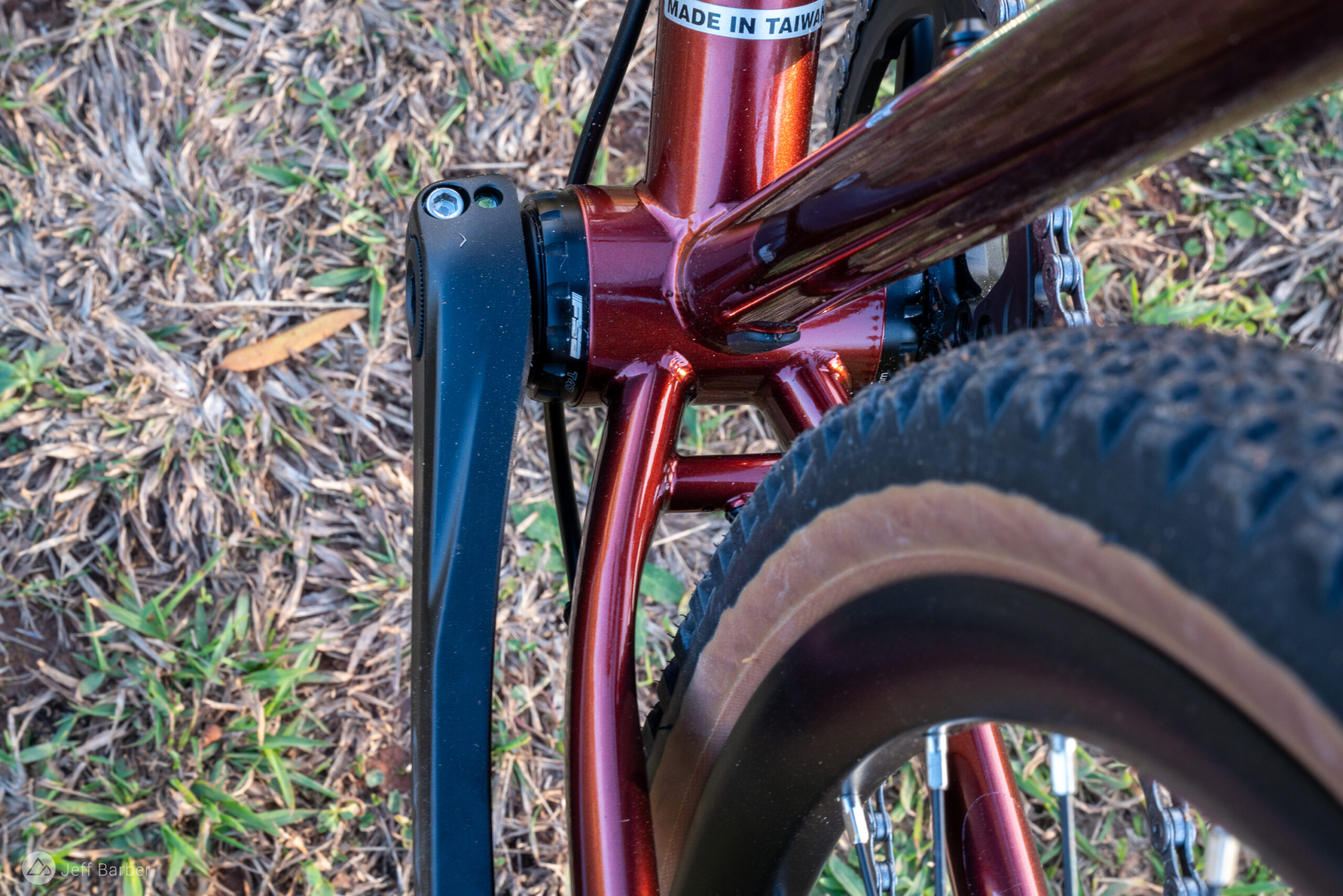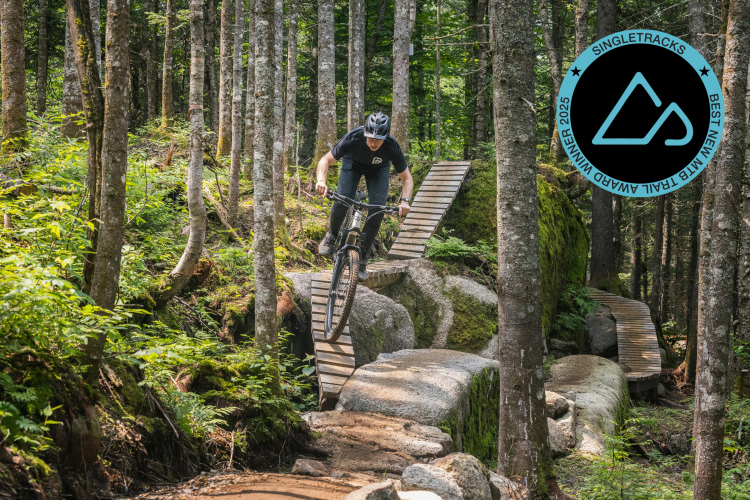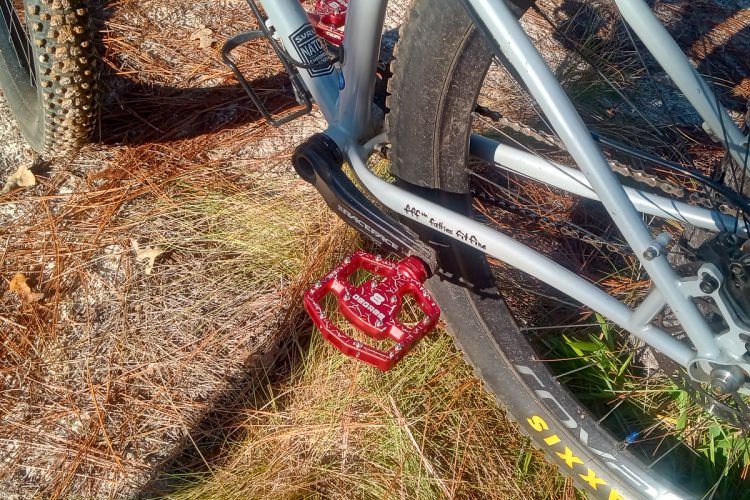
“Gravel bikes are basically just 1990s mountain bikes.” At least, that’s what mountain bikers — myself included — have been saying for the last few years. To see if that’s true, and to understand what progressive gravel bike geometry looks like today, I decided to dig into the geometry charts and talk with a custom bike frame builder.
Gravel bike geometry versus MTB geometry
Mountain bikers tend to focus on a few key geo numbers when comparing bikes: head tube angle (HTA), seat tube angle (STA), and reach. Considering head tube angles, today’s average gravel bike (71.3°) isn’t too far off a 2003 Specialized Stumpjumper FSR (70.5° HTA) or a 2005 Trek Fuel EX (71° HTA). Not only that, both bikes have seat tube angles in the 73° range, just like the average gravel bike today.
Looking at reach, the similarities aren’t quite as obvious. That’s in part because in many ways drop bar gravel bikes are much closer to road bikes than mountain bikes in both form and function. With drop bars, riders effectively have two or three hand positions on the bike — on the bars for climbing, in the drops for descending, and on the hoods for everything else.
So what appears to be a short average reach (401mm) or effective top tube length (583mm) on a gravel bike compared to a mountain bike doesn’t tell the whole story. If your hands are on the hoods your effective reach is much longer than the reported measurement, which is based on the distance to the head tube. Sadly we don’t know the reach of the 2005 Fuel EX or the 2003 Stumpjumper so instead we’ll look at effective top tube length since the two measurements are closely related.

Given the different hand positions on gravel versus mountain bikes, it’s not surprising that the 2000s-era Fuel EX and Stumpjumper average a much longer 619mm effective top tube compared to 584mm for a modern gravel bike. However, gravel bike handlebar reach can be significant, extending a rider’s hand position 60-90mm or more beyond the fully upright riding position reflected in the bike’s reach number. Not only that, gravel bikes tend to utilize longer stems than mountain bikes (though not too far off from those 2000s MTBs.) Riding in the drops, my educated guess is that gravel bikers are likely finding even longer effective reaches than on the mountain bikes from 20 years ago.
Any discussion about mountain bike geometry today tends to focus on how each measurement affects a bike’s handling, but as I found out that’s not necessarily what’s going on with gravel bikes at the moment. Generally speaking, most gravel bikes start with road bike geometry, which has been tried and true for many years, and translate fit and to a large degree bike handling to jive with wider tires. And that’s much easier said than done.

Tire clearance is what makes a road bike a gravel bike
Nate Zukas built his first “gravel bike” almost a decade ago, in 2014 or 2015. Riding in a Southern Cross “monster-cross” off-road race the custom frame builder experienced a lightbulb moment.
“People on a cyclocross bike [were] really dropping me on these uphills, climbing the mountains. But I caught right back up to them on my mountain bike. [I thought,] ‘I wish I could combine both,’ and the next thing you know, gravel bikes are starting to come out.”
Of course mountain bikes are distinct from cyclocross bikes in many ways, starting with suspension, dropper posts, and beefy tires. While only a few of today’s gravel bikes feature suspension or a dropper post, all of them are designed to run wider, and in most cases, knobbier tires than ‘cross bikes and certainly road bikes. However a wider tire results in steering that feels unfamiliar to those used to riding road and cyclocross bikes.
So gravel bikes tend to have a slightly slacker head tube angle than a road bike to take some weight off the front end without sacrificing too much control on the climbs. After all, the slopes found on gravel roads aren’t generally that much different than paved ones so climbing and descending capabilities should be similar.
“You’re trying to walk that balance of understeer and oversteer,” says Zukas.
Unlike on mountain bikes, many gravel bikes have size-specific head tube and seat tube angles. As it turns out, this is related to wider tires as well and likely toe clearance considerations too. Smaller gravel bike frame sizes have slacker head tube angles in part to reduce toe overlap at the expense of giving riders of all sizes similar handling and ride feel.
“You’re wanting to combine a wheel base, chainstay length, bottom bracket drop and front center to something that’s handling like a road bike, but has the ability to run a bigger tire. So that’s where you run into issues with toe overlap,” said Zukas. Varying the fork offset by frame size, rather than the head tube angle, pushes the front wheel away from the cranks and is an option for custom builders like Zukas, though most of the brands I looked at spec the same fork offset for all frame sizes and let the head tube angle float instead.
Another area where gravel bike geometry is distinct from road and mountain bike geometry is bottom bracket drop. Among drop bar bikes cyclocross bikes tend to have the least amount of bottom bracket drop in part to reduce pedal strikes on tricky courses. Today’s gravel bikes feature a greater bottom bracket drop — around 75mm — which places the rider more “in” the bike than “on top of” the bike for improved handling. Yet again, this comes back to tire size.
“It’s like when the 29ers came around, everybody was like, ‘it’s the same geometry, just bigger tires,” said Zukas. “But then it’s like, ‘well we’re way up in the air.’ So you have to compensate for the fact that you’re going to bigger, larger tires” by giving the bike a greater bottom bracket drop.

Gravel bike geometry progression and trends
Considering that gravel is a relatively new bike category, will we see rapid progression and changes similar to what’s happened with mountain bike geometry that’s moving longer, lower, and slacker seemingly ad infinitum? It’s hard to say, though there are some bikes that are pushing the boundaries.
Among the well-known gravel bikes I looked at, only the Salsa Cutthroat and Santa Cruz Stigmata have head tube angles that are less than 70°. The Cutthroat for its part is designed for long-distance bikepacking races like the Tour Divide, a 2,700-mile race which sees riders on a roughly even mix between drop bar and flat bar bikes each year. The Stigmata, on the other hand, stands out not just for its slack head tube angle but also its long reach and steep seat tube, all superlatives that are prized in the mountain bike world where the brand is best known.
For gravel bike head tube angles to trend slacker as they have for mountain bikes, increased tire widths will likely be the driver. In fact, as you can see from the table at the bottom of this article there is a pretty strong correlation between a bike’s maximum tire (plus mud) clearance and its head tube angle. The 69° HTA Cutthroat is the slackest, and it’s also the bike with the widest maximum tire width at 57mm (2.25″).
Because gravel bikes are essentially lower than basically any category of bike already, it seems unlikely we’ll see bottom bracket drops go much beyond 80mm given that there’s a hard limit for ground clearance. The Giant Revolt and Specialized Diverge are two bikes with bottom bracket drops already in this range, and it’s notable that Specialized in particular says the Diverge is their “most progressive” gravel bike in terms of geometry. However, by speccing shorter cranks, brands could possibly eek out a few more millimeters of bottom bracket drop.
When it comes to length, it’s possible we’ll see gravel bike builders experimenting with shorter rather than longer chainstays. However, Zukas notes the need for a front derailleur on many gravel bikes poses an issue. “If we want to run a shorter chainstays we gotta go one-by.” And at this point not all gravel riders are willing to give up the gear range of a multi-ring setup.
Zukas is hearing that some riders are moving the saddle forward on gravel bikes, particularly for racing. This too could push gravel bikes shorter, rather than longer as mountain bikes have trended.
My takeaway after looking through the geometry data and speaking with Zukas is that, barring new standards or component preferences, gravel bike geo progression will be slow compared to the changes we’ve seen in mountain bikes due to the myriad constraints and considerations involved. Plus it seems road bike geometry was already pretty dialed and only needs to be tweaked a little bit to fit wider tires, which account for much of a gravel bike’s off-road handling capabilities anyway.
In the end, gravel bike frame design is about much more than “just sticking some tubes together,” according to Zukas. Finding the right measurements that fit both the rider and the bike’s components is the tricky part.
Select gravel bike geometries compared
Similar to our previous analyses of trail bike geometry we’ll be tracking gravel bike geometry over the coming seasons to understand how the bikes evolve.
| Bike | Tire Clearance | HTA | STA | Reach | Chainstay Length | Top Tube Length | BB Drop | Notes |
|---|---|---|---|---|---|---|---|---|
| Canyon Grail CF SL 7 AXS | 50mm | 71.5 | 73.5 | 427 | 425 | 609 | 75 | Head angle varies by size; released late 2023 |
| Specialized Diverge Comp Alloy | 47mm | 71.75 | 73.5 | 401 | 432 | 589 | 80 | The brand’s “most progressive geo” |
| Specialized Crux Comp | 47mm | 72.25 | 73.5 | 405 | 425 | 582 | 73 | 58cm frame; seat and head angles vary by size |
| Trek Checkpoint SLR 7 AXS | 45mm | 72.5 | 72.5 | 411 | 435 | 597 | 75 | 58cm frame; |
| Trek Domane SLR 7 Gen 4 | 38mm | 72 | 73 | 380 | 425 | 567 | 79 | 58cm frame; angles and chainstays vary by size |
| Giant Revolt Advanced 2 (2024) | 53mm | 72 | 73 | 397 | 430 | 585 | 80.5 | head & seat angles vary by size; short and long changes chainstay length |
| Orbea Terra M41E Team | 45mm | 71 | 73 | 395 | 420 | 570 | 77 | Clearance for 700c tires (650×50); angles vary by frame size |
| Santa Cruz Stigmata | 50mm | 69.5 | 74 | 420 | – | 592 | 75 | No chainstay length provided |
| Salsa Cutthroat C GRX 600 1X | 57mm | 69 | 74 | 395.13 | 445 | 580 | 70 | 58cm frame; STA varies by size; |
| Salsa Warbird C GRX 600 1X | 45mm | 70.75 | 73 | 390.42 | 430 | 575 | 70 | 51mm tire clearance for 650b wheel; 57.5cm frame; HTA and STA vary by size |
| Salsa Vaya GRX 600 | 45mm | 71.5 | 72.5 | 372 | 450 | 570 | 75 | 57cm frame; angles vary by size |
| Knolly Cache | 50mm | 70.5 | 74.0 | 417.0 | 422.0 | 593.5 | 75 | 58cm frame; BB height based on 40mm tire |
| Jamis Renegade S2 | 50mm | 72.0 | 73.0 | 396.0 | 430.0 | 589.0 | 71 | 58cm frame; angles vary by size; |
| Enve MOG | 50mm | 71.5 | 73.2 | 405.0 | 420.0 | 588.0 | 73 | 58cm frame; angles vary by frame size; BB height for 44mm tire; BB drop varies by frame size |
| Pivot Vault | 72.0 | 73.0 | 398.0 | 420.0 | 578.0 | 70 | lg (56.8cm) | |
| AVERAGE | 71.3 | 73.2 | 400.6 | 429.2 | 584.3 | 74.6 |







0 Comments